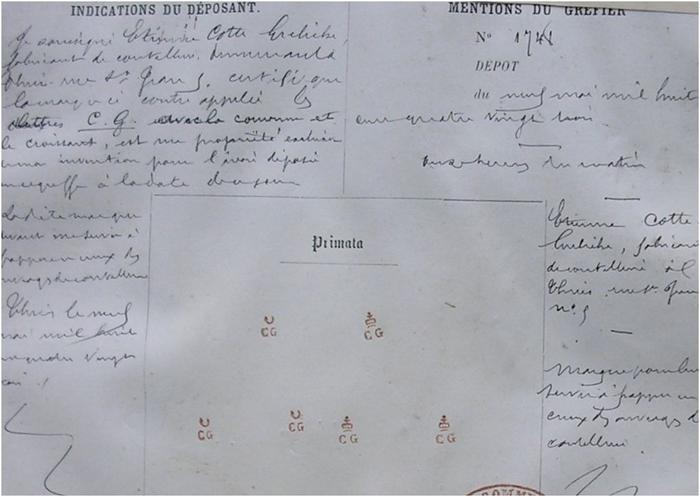Results 11 to 17 of 17
-
02-04-2013, 06:07 PM #11Historically Inquisitive



- Join Date
- Aug 2011
- Location
- Upstate New York
- Posts
- 5,782
- Blog Entries
- 1
Thanked: 4249
The letter O doesnt look like a complete circle, and the letter C could very well be a G. If using the letters C. G. there is a makers from thiers that used these letters with a crown. Cotte Greliche, coutellerie Thiers France.
The problem is that in Thiers Makers marks using a crown followed with makers name or initials goes back to 1591 some only followed the crown with a number somewhat like Thiers Issard 69.


And the 1883 trademark registration.

Last edited by Martin103; 02-04-2013 at 06:28 PM.
-
The Following User Says Thank You to Martin103 For This Useful Post:
BlueDun (02-05-2013)
-
02-04-2013, 07:22 PM #12Senior Member



- Join Date
- Apr 2008
- Location
- Essex, UK
- Posts
- 3,816
Thanked: 3164
In all those examples, both the C and the G have serifs, and the G is different at the bottom than at the top. In the photo, the serifs at top and bottom of the second letter are equal, making it look more like a C than a G. Might just be wear, though.
However, it might not be from the Thiers region - the other centre for cutlery was Nogent, and in the 1880s there was Olympe-Chauvin there (also listed in the 1840s as successors to DuBois). Can't find a mark for them, though, or much info - only a handful of references that aren't that helpful.
Regards,
Neil
-
02-05-2013, 09:26 AM #13Junior Member

- Join Date
- Jul 2010
- Location
- Switzerland
- Posts
- 20
Thanked: 10
Thanks so much gentlemen for your inputs so far. France came also to my mind as possible origin of this razor. The shape of the blade and just the whole making - I find similarities in the other French razors I own (and I like the French A LOT)
Regarding age I tend to believe that it is not that old. Two reasons for this:
First, the near-mint condition. The scales are pretty much flawless. The blade did have some rust but this was not really deep. The largest part of the blade had it's original mirror-polish. As I wrote above, the blade seemed absolutely unused. No hone war at all and the edge looked like a factory edge under the microscope. With moderate polishing the rust left only some very shallow scars. You can see that on the bottom left picture.
The older the razor actually is, the less likely it will survive like this.
Second, the grind. It's an extreme hollow. Not a Solingen style double hollow but really thin and perfectly ground. I do not now when the razor manufacturers actually were able to manufacture to such standards. I don't even know if they were up to that around 1900 as Neil suggested for a possible creation date. I will try and make some close-up shots on the weekend to illustrate.
Cheers
BlueDun
-
02-05-2013, 03:05 PM #14

Oh Yes! They were grinding them thin way before 1900!
 "Don't be stubborn. You are missing out."
"Don't be stubborn. You are missing out."
I rest my case.
-
02-28-2013, 08:34 AM #15Junior Member

- Join Date
- Jul 2010
- Location
- Switzerland
- Posts
- 20
Thanked: 10
-
02-28-2013, 09:03 AM #16Senior Member

- Join Date
- Dec 2012
- Location
- Melbourne, VIC, Australia
- Posts
- 352
Thanked: 28
I agree with Martin I dunno I just have a feeling that he's right, and yeah BlueDun the crowns do look similar. but more importantly, that razor looks AWESOME! I am jealous and I've already bought 3 new razors in the last 2 days.
-
02-28-2013, 02:49 PM #17< Banned User >

- Join Date
- Aug 2012
- Location
- Greenwood, Nova Scotia
- Posts
- 1,144
Thanked: 116
What a gorgeous instrument! That's one helluva keeper you've got there!


 13Likes
13Likes LinkBack URL
LinkBack URL About LinkBacks
About LinkBacks






 Reply With Quote
Reply With Quote